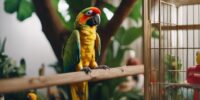What Conservation Efforts Are in Place for Endangered Parrot Species?
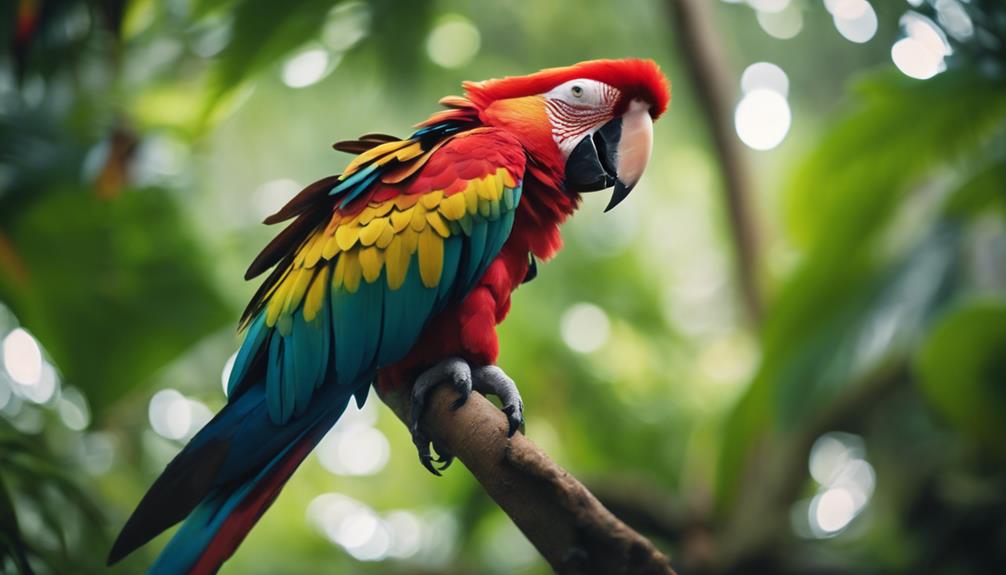
Conservation efforts for endangered parrot species play a crucial role in protecting these birds from extinction. The decline in parrot populations is often due to habitat loss, poaching, and illegal wildlife trade. Various organizations and governments are working together to implement strategies to conserve and protect these species.
These efforts include creating protected areas, breeding programs, and raising awareness about the importance of preserving parrot populations. By studying their behavior and habitats, researchers can develop effective conservation plans to help these birds thrive in their natural environments. Ultimately, these conservation efforts aim to ensure the survival of endangered parrot species for future generations.
Protected Areas for Parrots
Protected areas play a crucial role in safeguarding the habitats of endangered parrot species, ensuring their continued survival and protection. Habitat restoration within these protected areas is vital for creating suitable environments for parrots to thrive. By restoring degraded habitats, conservationists can provide parrots with the necessary resources for breeding, nesting, and foraging.
Furthermore, protected areas offer ecotourism benefits that can generate income for local communities while promoting the conservation of parrot species. Through responsible ecotourism practices, visitors can appreciate these majestic birds in their natural habitats, raising awareness about the importance of preserving these environments. This, in turn, can lead to increased support for conservation efforts and sustainable practices.
Breeding Programs for Conservation
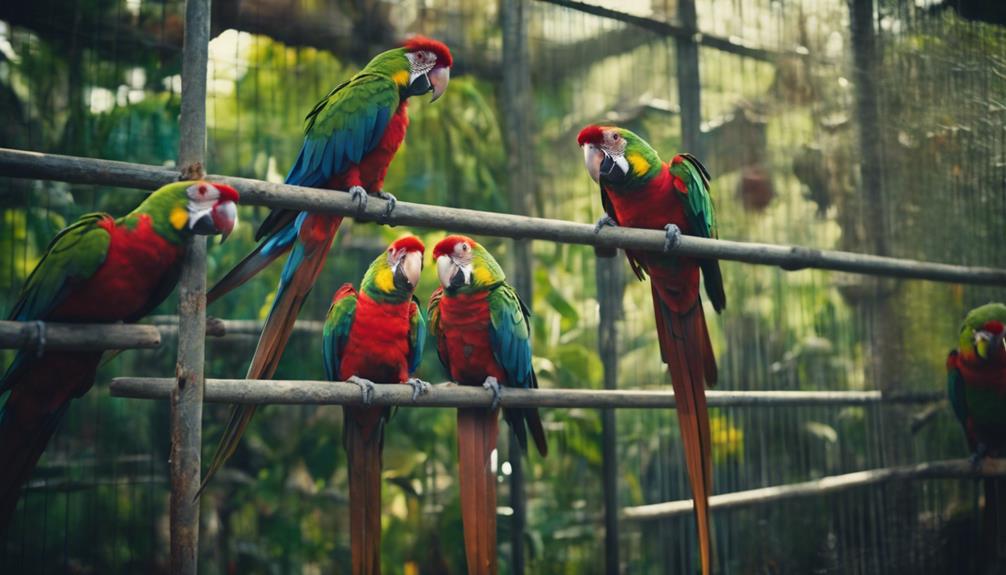
To enhance the long-term survival prospects of endangered parrot species, targeted breeding programs are being implemented to bolster population numbers and genetic diversity. Captive breeding plays a crucial role in these programs by providing a controlled environment for breeding pairs to reproduce without the threats they'd face in the wild. Through careful selection of breeding pairs, genetic diversity can be maintained, reducing the risk of inbreeding and preserving the overall health of the population.
These programs often collaborate with zoos, aviaries, and conservation organizations to ensure the success of breeding efforts. By tracking genetic lineages and monitoring breeding outcomes, conservationists can make informed decisions to maximize the effectiveness of captive breeding initiatives. Ultimately, these programs aim to increase the number of parrots bred in captivity, with the goal of eventually reintroducing them into their natural habitats to support wild populations and ensure the long-term survival of endangered parrot species.
Community Education Initiatives
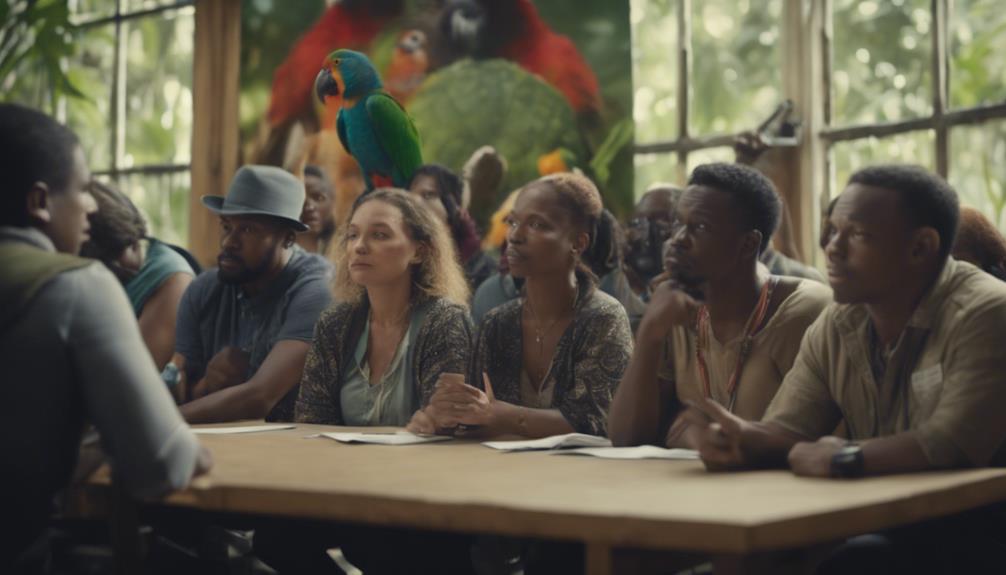
How can community education initiatives contribute to the conservation of endangered parrot species? Community education plays a vital role in raising awareness, fostering understanding, and promoting active participation in conservation efforts. Here are three impactful ways these initiatives can make a difference:
- Interactive Workshops: Hosting interactive workshops can engage community members of all ages in learning about the importance of protecting endangered parrot species. These workshops can include hands-on activities, educational presentations, and interactive discussions to deepen participants' knowledge and commitment to conservation.
- School Programs: Implementing conservation-focused programs in schools can instill a sense of environmental responsibility in the younger generation. By integrating curriculum-based lessons on endangered parrot species and their habitats, students can develop a strong connection to wildlife conservation from an early age.
- Community Outreach Events: Organizing community outreach events such as conservation fairs, birdwatching tours, and habitat restoration projects can further involve the public in conservation initiatives. These events provide opportunities for individuals to actively contribute to the protection of endangered parrot species while fostering a sense of community and shared environmental stewardship.
Anti-Poaching Laws and Enforcement
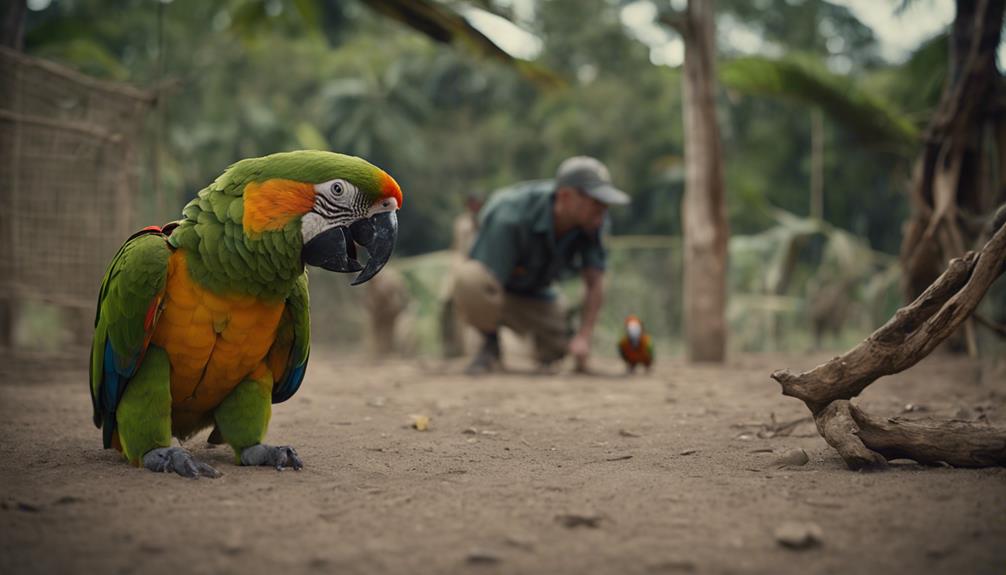
Community education initiatives are crucial in raising awareness about the importance of anti-poaching laws and enforcement for the conservation of endangered parrot species. By implementing increased penalties for wildlife trafficking and strengthening enforcement efforts, governments can deter poachers and protect these vulnerable birds from illegal activities.
To illustrate the impact of anti-poaching laws, consider the following table:
| Anti-Poaching Measures | Benefits |
|---|---|
| Increased Penalties | Deterrence of Poachers |
| Strengthened Enforcement | Improved Wildlife Protection |
| Wildlife Trafficking Prevention | Reduction in Illegal Trade |
These measures not only safeguard endangered parrot species but also contribute to the overall ecosystem health. By focusing on wildlife trafficking prevention strategies and enacting stricter regulations, authorities can combat the illicit trade that threatens the survival of these magnificent birds. Strengthening anti-poaching laws and their enforcement is a critical step towards ensuring a sustainable future for endangered parrot populations.
Rehabilitation and Release Programs
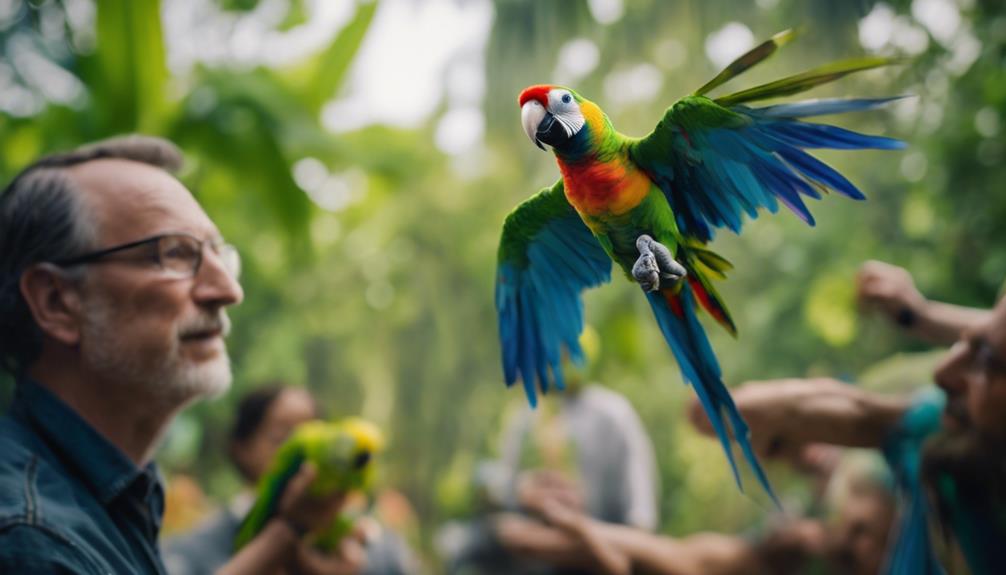
Rehabilitation and release programs play a vital role in the recovery and conservation of endangered parrot species. These programs aim to reintroduce rehabilitated parrots back into their natural habitats, bolstering wild populations and genetic diversity.
Here are three key components of successful rehabilitation and release programs:
- Captive Breeding: Establishing controlled breeding programs ensures a sustainable source of parrots for release into the wild. By carefully managing breeding pairs and offspring, conservationists can maintain healthy population numbers and reduce the pressure on wild populations.
- Habitat Restoration: Rehabilitated parrots need suitable habitats to thrive once released. Habitat restoration efforts involve reforestation, protection of critical habitats, and removal of invasive species to create an environment conducive to parrot survival.
- Post-Release Monitoring: Tracking the progress of released parrots is essential to evaluate the program's success. Monitoring the behavior, survival rates, and breeding success of rehabilitated parrots provides valuable data for refining future conservation efforts.
International Collaboration Efforts
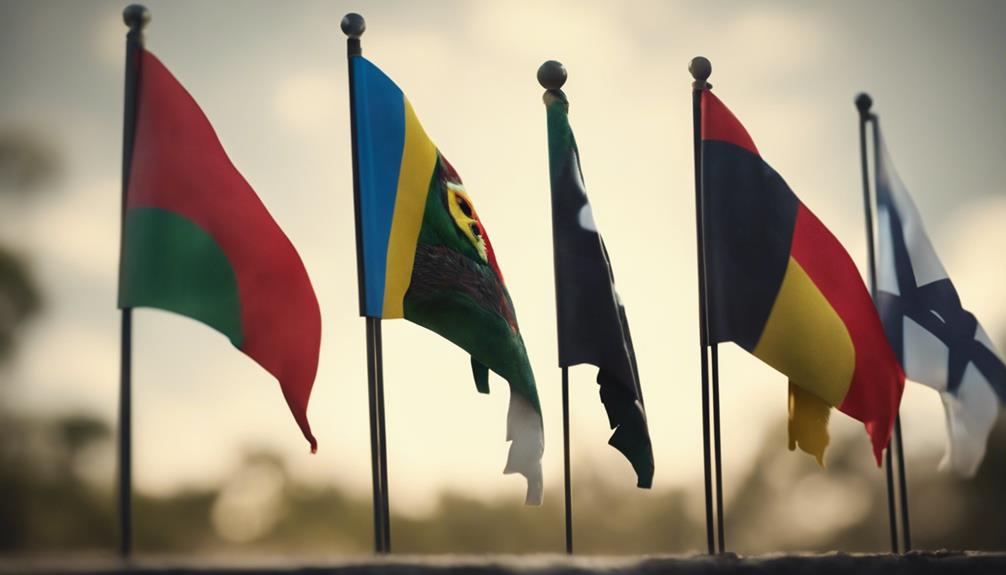
International collaboration efforts are crucial in addressing the complex challenges faced by endangered parrot species and ensuring their long-term survival. These efforts involve partnerships between governments, non-profit organizations, and international bodies to pool resources and expertise. One key aspect of international collaboration is securing funding from various sources, such as governmental grants, private donations, and international conservation funds. This financial support is essential for implementing conservation projects, conducting research, and establishing protected areas for parrot species.
Moreover, international collaboration on parrot conservation also has significant policy implications. By working together, countries can develop and implement policies that protect parrots across their migratory routes and habitats. These policies can include regulations on trade, habitat protection measures, and international agreements to combat illegal trafficking of parrots. Through coordinated efforts, stakeholders can ensure that policies are effectively enforced and that conservation actions are aligned with global objectives. Ultimately, international collaboration is key to safeguarding endangered parrot species for future generations.
Research and Monitoring Initiatives
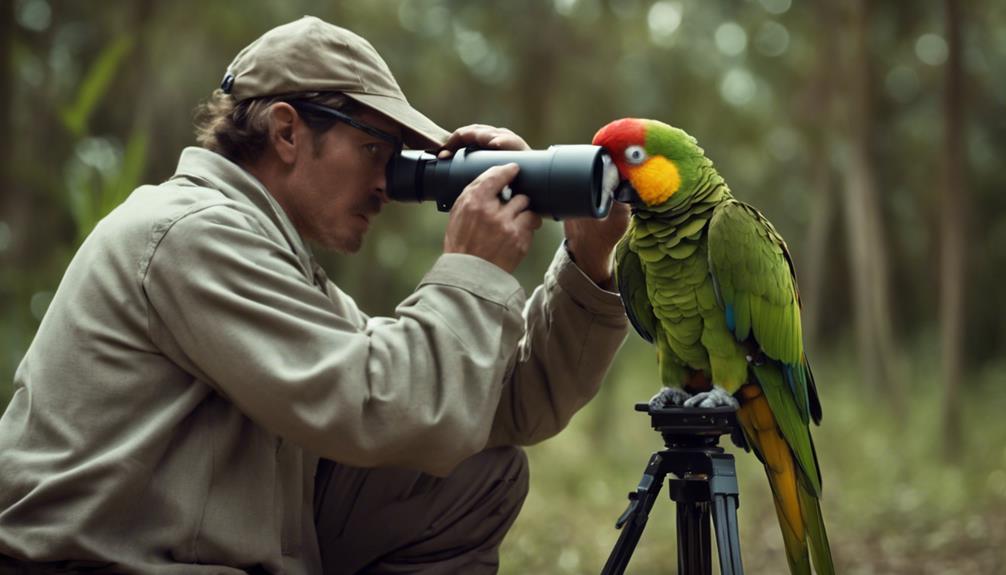
Effective monitoring and research are pivotal for assessing the status of endangered parrot species and guiding conservation efforts. To safeguard these majestic birds, several key initiatives are being implemented:
- Population Surveys: Scientists conduct regular population surveys to monitor the size and distribution of endangered parrot species. This data helps in understanding population trends and identifying critical habitats that require protection.
- Disease Prevention Strategies: Researchers are developing and implementing disease prevention strategies to safeguard parrot populations from threats like avian malaria and psittacine beak and feather disease. By mitigating disease risks, the survival chances of these vulnerable species are significantly improved.
- Captive Breeding Efforts: Conservation organizations are investing in captive breeding programs to increase the population numbers of endangered parrot species. These initiatives aim to create sustainable captive populations that can act as a genetic reservoir and potentially support future reintroduction efforts into the wild.
Through these research and monitoring initiatives, conservationists are actively working towards ensuring the long-term survival of endangered parrot species.
Frequently Asked Questions
How Do Parrot Conservation Efforts Impact the Local Economy in Areas Where These Birds Are Endangered?
Parrot conservation efforts have a positive impact on the local economy by boosting tourism through eco-friendly initiatives. This leads to increased revenue for communities and creates sustainable livelihoods that benefit both people and wildlife.
What Are Some Challenges Faced by Conservationists When Trying to Reintroduce Captive-Bred Parrots Into the Wild?
Conservationists face several challenges when reintroducing captive-bred parrots into the wild. These include issues with adapting to natural environments, social integration with wild populations, and ensuring survival skills are developed adequately for sustainable reintroduction efforts.
Are There Any Cultural or Traditional Beliefs That Hinder Conservation Efforts for Endangered Parrot Species?
Cultural beliefs can sometimes hinder conservation efforts for endangered parrot species. Traditional practices may conflict with conservation goals, leading to challenges in implementing effective strategies. Overcoming these obstacles requires understanding and respectful collaboration with local communities.
How Do Climate Change and Habitat Destruction Affect the Success of Parrot Conservation Programs?
Climate change and habitat destruction significantly impact the success of parrot conservation programs. These challenges necessitate innovative conservation strategies, including habitat restoration, captive breeding programs, and community involvement to safeguard endangered parrot species for future generations.
What Role Do Local Communities Play in Monitoring and Reporting Illegal Parrot Trade Activities in Their Area?
Community involvement is crucial for monitoring and reporting illegal parrot trade activities. Local communities provide vital eyes and ears on the ground, aiding in identifying and stopping illegal trade, ultimately safeguarding endangered parrot species.



